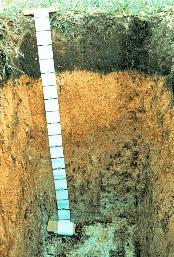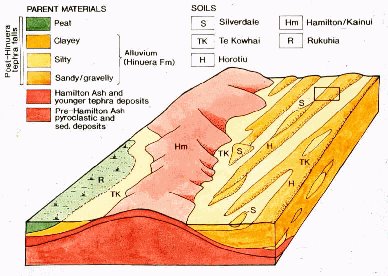On a soil map of a region it is difficult to show soil variation even on a farm scale, so the ability to identify a soil in the field has the advantage of overcoming any problems associated with changes in soil type over short distances.
The importance of this is becoming more evident with increased interest in intensive horticulture, for even within-paddock, soil variation can be important for determining the success or failure of a crop.

How are soil maps made?
By digging holes and taking soil cores, soil scientists are able to locate and map areas of land dominated by a particular soil.
Mapping of soils is aided by an understanding of soil/landscape relationships - low flat areas may be dominated by white, poorly drained clayey soils, slightly higher ground by well drained yellowish sandy soils.
The areas of land occupied by soils are plotted on a map.
After this procedure has been repeated many times and cross-checking and assessments have been undertaken, a complete soil map for an area is built up.

It is important that the limitations of soil maps are understood.
Soil variations can be quite distinctive over a distance of just several metres.
It is possible in some areas to have several different soils within one paddock, whereas another area may have one soil covering hundreds of hectares.
If a soil map is produced at a very detailed scale, say 1:5000 (where 1 cm2 of map represents 0.25 ha), several different soils would probably be able to be shown within a single paddock.
If, however, the map scale is not very detailed, such as 1:50000 (where 1 cm2 of map represents 25 ha), it is very difficult if not impossible to show all of the soils found within a local area - of necessity, the most common soil would be shown as if it were occupying the entire (25 ha) area.
Nevertheless, less detailed soil maps showing only the generalised soil distribution of an area are useful, especially to people who work at a national or regional level.
General soil maps provide a broad perspective of the soils and landscapes in an area, locating large areas of a particular soil type most suited to certain types of farming or other land uses.
Areas of soil with properties that are unfavourable for certain land uses can also be identified.
Detailed soil maps are often produced for special areas where accurate knowledge of soil distribution is required, such as for research stations or horticultural developments.
Guide: now that you know about the reasons for identifying a soil, continue with the Next Topic on How this identifcation is done.